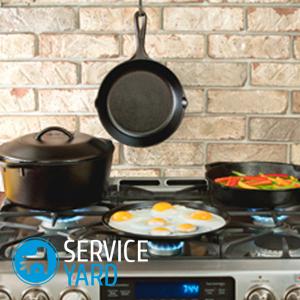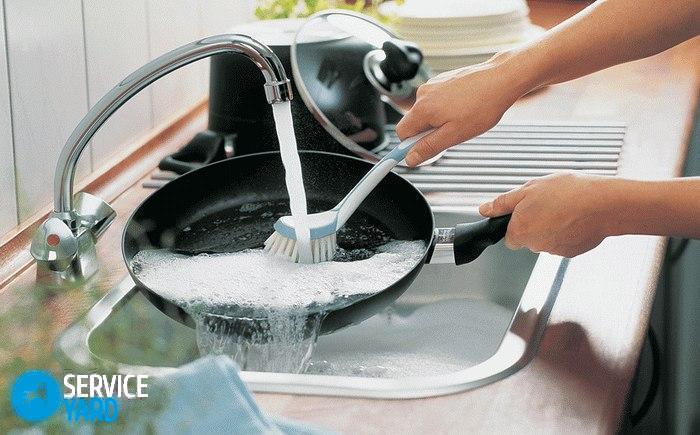Cast Iron Pan Care

Surely each of us has seen cast-iron frying pans in the kitchen at least once in a lifetime. We looked at them, but never thought about how our grandmothers looked after those bulky and heavy pans, and after all, such dishes have served them for several decades. In order to arrange proper care for the cast-iron pan, you need to know some points that we will try to tell about in this article.
to contents ↑Processing a new pan
As soon as you bought a new cookware made of this metal, immediately begins to care for the cast-iron frying pan. Fortunately, he is not burdensome.
Wash, Dry Your New Frying Pan
Use warm soapy water, as well as a brush, to completely clean the pan. This will help you remove any chemicals or any other residues in the pan so that they cannot get into the food you are cooking.
Make sure the pan is thoroughly dried.
Preheat the oven to 170-200 C
Rub a brand new cast-iron frying pan with oil and heat the oil until it evaporates completely on the cast-iron surface. This will help to create a non-stick coating that can protect your pan from corrosion, and form an ideal surface in order to cook a variety of foods - from pancakes and scrambled eggs to a variety of delicacies.
Important! After you have washed and calcined the pan for the first time, do not reuse the brush, because it will remove the same precious non-stick layer that you want to keep.
Cover the pan with a layer of fat
You can use lard, olive or vegetable oil:
- Take a paper towel to distribute the fat in your pan over its entire surface.
- Try not to miss the slightest stain when you grease the pan with grease. If you miss a place, it will not be able to get a protective coating, as a result of which it will be susceptible to corrosion.
- Place the pan in the oven.
- Bake the pan for 2 hours to make sure that the protection layer is fully formed.
- After 2 hours, remove it from the oven, and then place it on a sufficiently warm, safe surface so that it cools down.
Important! The fat will be fried in a pan, thereby combining with iron to become a layer of protection. Do not worry, you will not feel any smell or taste when the process is completed.
Repeat the process
If you wish, you can repeat the procedure described above to make sure that the protective coating does not come off the surface of the walls of the pan when you cook your dishes in a pan. When you complete this initial treatment, the oil that you will use during cooking will keep the pan in great shape.
to contents ↑Important! Whenever you cook, the non-stick properties of the surface pan will begin to improve.
What to do when a deposit appears?
During the use of kitchen utensils, the formation of contaminants will be inevitable. Caring for a cast iron pan involves removing them. But the methods can be different, including without your direct participation.
Appliances
All kinds of modern devices help housewives to carry out proper care and clean utensils from soot.
Most ovens as well as dishwashers have this special self-cleaning function. They are able to eliminate even severe pollution. To do this, just put the pan in the oven and turn on the self-cleaning function.
Chemicals
To eliminate strong carbon deposits:
- A special tool is applied to the dishes, after which it is tightly wrapped with polyethylene.
- After 8-10 hours, the film is removed.
- After this manipulation, the dishes must be thoroughly washed with running water.
Carbon from the pan disappears instantly and without a trace.
Important! To remove a thick layer of soot from dishes, you can use any cleaning products, even to eliminate blockages in the sewer and cleaning the ovens.
Put on protective gloves, then for a short time put a contaminated pan in such a product. After that, wash the remaining residue from the surface of the dishes with particular care.
to contents ↑What if there is an allergy to household chemicals?
Although we have already become accustomed to an integral part of our life - diverse chemistry, the body of some people does not perceive it and renders its “dissatisfaction” with allergies. If you have such features or just want to establish a healthier life, take note of the following ways how to care for a cast-iron frying pan.
Method 1
In those days, when cooking took place on an open fire in the ovens, the care was simple. In order to prevent the formation of soot, the housewives simply left cast-iron utensils in a hot oven. And in the morning the dishes were doused with strong boiling water. After that, they had to clean it a little from the already fallen off soot.
Method 2
Here's another grandma’s way of looking after a cast-iron pan if there is a large layer of soot:
- Take a large basin and fill it with water, one or two tubes of PVA glue, laundry soap and soda.
- Put the basin along with water, as well as grated laundry soap on the stove.
- Add a pack soda ash.
- Place the pan in boiled water, and cook it for 2 hours.
Important! You definitely won’t like the smell, so open the window or simply turn on the hood at maximum power.
- Pour the water out of the bowl and then cool the pan.
- Remove soft carbon with a wire brush and thoroughly clean the pan.
Important! At the end of this procedure, be sure to bake the pan again, as described at the beginning of the article. Otherwise, the food will burn.
Method 3
You can get rid of dense soot in a cast-iron skillet even in nature - just throw it in an already extinguished fire. After this procedure, the deposit itself will fall off.
True, in this case, be prepared for the fact that a strong offspring will begin to spread - so move away from the outbreak.
to contents ↑Important! Do not miss the moment when you will have to get out the pan, not allowing it to deform. The utensil cannot withstand such a high temperature.
Proper care of cast iron utensils
Care for dishes that are made of cast iron, you need to regularly enough. After each use, your favorite pan must be tackled. It only takes a few minutes:
- Remove all the burnout inside, if there is one - you can fill the vessel inside with water and boil it.
- Next - we bring the utensils to the sink and remove the remaining dirt, grease, sponge with detergent.
- Be sure to wipe the dish well at the end, as keeping it moist is unacceptable.
Stock footage
Now you know how to make a cast-iron frying pan a real property of your family, and having organized proper care for the dishes, you can pass it on to the next generation, telling you how to properly care for such dishes.
- How to choose a vacuum cleaner taking into account the characteristics of the house and coatings?
- What to look for when choosing a water delivery
- How to quickly create comfort at home - tips for housewives
- How to choose the perfect TV - useful tips
- What to look for when choosing blinds
- What should be running shoes?
- What useful things can you buy in a hardware store
- Iphone 11 pro max review
- Than iPhone is better than Android smartphones



